• Control your Arduino pins with our/your own mobile App
• Send sensor data from your Arduino to an App for processing
• Use your mobile device as an internet gateway for your Arduino
• and much more!
BLE shield could operate under 3.3V or 5V, therefore it works with a lot of Arduino compatible boards too.
New Features in BLE Shield Version 2.1
1. Reset button is changed to "side button"
2. nRF8001
SPI pins can be set to either Pins 11-13 on the side or ICSP, this
allows other Arduino compatible boards with no ICSP header such as
FRDM-KL05 board, RedBoard and so on to interface with the nRF8001 BLE
chip
3. Flexible REQN and RDYN pins selectable from pin 2 to 10
4. The board is shorter than before and this allows it to fit on Arduino Yun physically
Features Since v2.0
1. Besides the on-board PCB antenna, option to use SMA connector for external antenna (soldering is required)
2. Flexible REQN and RDYN pins selectable from pin 2 to 12, these pins are fixed at 8 & 9 for BLE Shield v1
3. Reset button also resets the Arduino board, and vice versa
4. ICSP header provides Vcc (for other shields to get power source)
5. ICSP header now passes through (for other shields to connect to the SPI)
6. Shield's reset is controllable by Arduino pin 4 or 7
7. Reset signal to the shield is now active low (i.e. pull low to reset the shield)
8. Added test points for power consumption measurement of the nRF8001 chip (soldering is required)
9. Added circuitry and test pin (J9 NC) for measurement of instant working current (using logic analyzer, 1mA = 100mV).
Supported BLE Central Devices
iOS 7
• iPhone 4s
• iPhone 5 (all models)
• iPod touch 5
• iPad 3/4/mini/Air
Android 4.3 or above (4.4 recommended for stability) with Bluetooth 4.0 hardware support
• Nexus 4
• Nexus 7
• Samsung Note 3 / GT-I9300 / GT-I9500
(please report any other Android devices supported)
Windows 8.1 with built-in Bluetooth 4.0 or USB dongle
Mac OSX 10.9.2 with built-in Bluetooth 4.0 or USB dongle
Linux with BlueZ 5.1 with built-in Bluetooth 4.0 or USB dongle
Getting Started Guide
How It Works
• BLE Shield
communicates with Arduino through the ACI (Application Controller
Interface). The ACI is similar to SPI but does not actually work as SPI.
SPI is consist of MOSI, MISO, SCK and SS, whereas ACI is consist of
MOSI, MISO, SCK, REQN and RDYN.
• Since BLE Shield may receive data anytime even not selected by SPI master (Arduino), so the SS line is not needed.
• In ACI,data exchanged still through MOSI and MISO, and SCK provides the clock generated by master.
• When
master wants to request data from BLE Shield, it puts the REQN to low
until RDYN line is put to low by BLE Shiled, and then master generates
the clock to read out the data. After reading out the data, master will
release the REQN and BLE Shield release the RDYN, put them to high.
• If BLE
Shield has data to transmit to master, it will put the RDYN to low to
indicate master, even though master havn't requested data and REQN is
idle. If master detectes a low level condition on RDYN, it will put REQN
to low and generate the clock to read out the data.After reading out
the data, both REQN and RDYN will be put to high.Note that REQN is
controlled by master while RDYN is controlled by BLE Shield.
Technical Details
Nordic nRF8001 Bluetooth Low Energy IC
• Support Peripheral (Slave) role operation only – nRF8001 IC limitation.
• Proprietary simple serial interface – Application Controller Interface (ACI).
Application Controller Interface (ACI)
• The ACI enables an application controller to communicate with nRF8001.
• The
physical ACI interface on nRF8001 consists of five pins. All ACI data
and exchanges use a standard SPI interface, with nRF8001 using a mode 0
slave interface to the application controller.
• However,
nRF8001 does not behave as a pure SPI slave device; nRF8001 can receive
new data over-the-air at any time or be busy processing a connection
event or new data. Consequently, the traditional CSN signal used to
initiate an SPI transaction is replaced by two active low hand-shake
signal; RDYN and REQN.
|
Signal
|
Arduino
|
nRF8001
|
Description
|
|
MISO
|
Input
|
Output
|
SPI: Master In Slave Out
|
|
MOSI
|
Output
|
Input
|
SPI: Master Out Slave In
|
|
SCK
|
Output
|
Input
|
SPI: Serial data Clock
|
|
REQN
|
Output
|
Input
|
Application controller to nRF8001 handshake signal
|
|
RDYN
|
Input
|
Output
|
nRF8001 to application controller handshake signal
|
Shield Layout
A. nRF8001 & Arduino board Reset Button
B. Factory Testing Pins
C. Power On LED
D. Flexible REQN and RDYN pins from pin 2 to 10
E. External Antenna
F. Onboard Antenna
G. Nordic nRF8001
H. Optional Pin to Control the Shield’s reset
I. Power Consumption Measurement of the nRF8001 chip
J. Power Monitor on Oscilloscope
K. SPI interface connection for nRF8001
Resources
Support
For questions about Nordic Bluetooth low energy SDK for Arduino,
 Cubieboard
Cubieboard
 Raspberry Pi
Raspberry Pi
 Arduino
Arduino
 Development Boards
Development Boards
 Multi-Rotors &Drones
Multi-Rotors &Drones
 Internet Of Things
Internet Of Things
 Communication Module
Communication Module
 Tools&Equipments
Tools&Equipments
 Accessories
Accessories







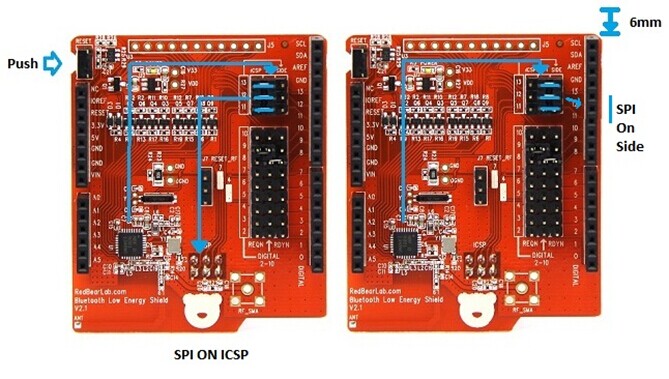
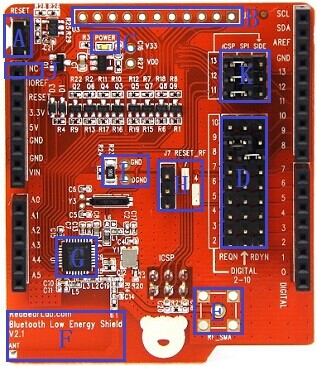
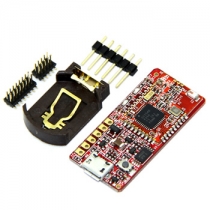
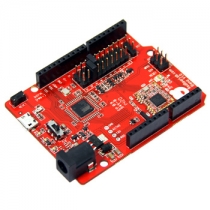
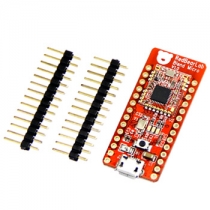
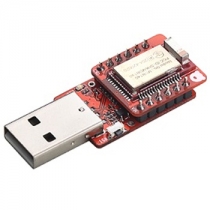
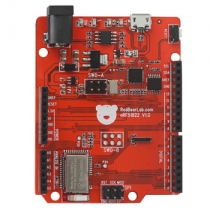












Not related record found